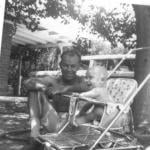 I shook off the cold as I walked through the house. It was a tidy 5 degrees outside. The wind chill performed meteorological subtraction bringing that “5” down to -1. Taking off my scarf, I found my wife folding my shirts into what resembled thick rectangular envelopes. I threw my coat on the bed, “I see you’re tidying up.” She nodded, grinning.
I shook off the cold as I walked through the house. It was a tidy 5 degrees outside. The wind chill performed meteorological subtraction bringing that “5” down to -1. Taking off my scarf, I found my wife folding my shirts into what resembled thick rectangular envelopes. I threw my coat on the bed, “I see you’re tidying up.” She nodded, grinning.
The night before we watched the first episode of Netflix’s Tidying Up with Marie Kondo. Much ink has been spilled about this series, noting some of the strangeness of Kondo’s organizational method. Most of the critique has been taking one key concept from the show – getting rid of items in your house that don’t “spark joy”. The jokes come quite easily.
My tax forms don’t spark joy, I should get rid of them.
These kids don’t spark joy…
Certainly this job doesn’t spark joy…
You see where this could go.
The idea of joy is the beating heart of what is called the KonMari method of tidying our houses. Basically, we take our possessions – clothes, kitchen stuff, garage stuff, and the miscellaneous in-between – and we engage in a discussion.
Does this item spark joy in me?
If not, you get rid of the item. First you thank the item for the service it provided you, then you get rid of it. Though it seems odd to “thank” our possessions, there isn’t much to critique here.
The basic idea of gratitude is being grateful to and for whatever is giving life to you. Theologically, every created thing has its root in God so thanking our stuff doesn’t bother me.
However, this clearly bothers others.
Much of the Christian response has been either skepticism or dismissal, and there is a long-standing reason for that kind of response.
Christianity in the modern era has struggled to understand both the concept of joy and the place of the “material” in the life of faith. Salvation is rescue from the material, we think. We then find the world and everything in it expendable or worthless when it comes to the journey with Jesus.
And that’s the problem. This isn’t the theology of Jesus, it is the theology of Plato.
The critique of Marie Kondo that I see in many Christian bloggers is that things don’t spark joy, God does. While I don’t disagree with that theologically, my follow up question is this: What is joy then?
The most joyful moment at the climax of the book of Revelation is the presence of a “new heavens and a new earth.” (Revelation 21:1). It is a renewed material world, not an obliteration of the stuff in which we live. Here is where I think the problem with Kondo is exemplified:
We struggle to define joy in the sense of how it relates to materiality.
We say joy is a theological or religious experience. It may also fall into the category of states of mind or condition of heart. I’ve written before about the difference between joy and happiness, so I’m not opposed to the above conditions.
However, to object to Marie Kondo from the theological position that only God sparks joy and our stuff is worthless is to divorce the presence of God from our interaction with materiality.
The richness of the Christian tradition is taking joy in the event of God becoming material (literally “enfleshing”) in Jesus.
In Hebrews, the writer says that is was “joy set before him” (Hebrews 12:2) that gave Jesus the impetus to move towards and through the event of the cross. This isn’t some ethereal plain on which Jesus is operating: it is the real flesh, the real wood, the real mineral composites that form the crucifixion.
Christians need to interact with Marie Kondo’s method because it reengages us in the discussion of what our stuff has to do with our soul.
I believe that Kondo’s work invites followers of Jesus into a very healthy tension.
The tension is as follows:
- Our spiritual lives unfold on the stage of materiality. Our stuff affects our souls.
- Material things are both sources of distraction and unhealth as well as sources of gratitude.
- The process of “tidying up” reintroduces us to the tension in how our stuff fits into our souls.
Jesus says that “life does not consist in the abundance of possessions.” (Luke 12:15) The caveat (if I might caveat Jesus) is that our souls are constantly interacting with a subsistence on possessions.
Even when we stop craving excess and eliminate it, how do we relate to what is left? What is our spiritual connection to the “enough” that remains?
The process of tidying up is in fact, a spiritual discipline where we meditate on the role of stuff in our life and “repent” (literally “change our thinking”) about what stuff we need based on what gives us joy.
The Impact of “Tidying Up”
So I “Kondo’d” my closets. I’m not sure if she intented that word to become a verb, but it is in our house. My wife and I already live fairly simply and with a ruthless ethic of keeping only what we need, so it wasn’t a painful process. However, the idea of interacting with our stuff – specifically clothes – began a dialogue we didn’t expect.
Holley began to look at shirts from various events: concerts, marathons, vacations. She remembered the joy of being with family and the blessing of resources that allowed those events to happen.
The order of my shirts in my drawer allows for a simpler selection process in the mornings. Instead of rifling through, I can see what I’m looking for and just pull it out. That might sound obsessive, like something that won’t last or is insignificant to spiritual growth.
Yet there is more space now to think, to pray, to feel the order of a day even in the order of my drawers.
What is your relationship with your “stuff”? Is there joy in an overflowing closet, a storage unit filled with things you haven’t thought about in a year? Is there a possibility that God may be inviting you to a discussion within your stuff?











